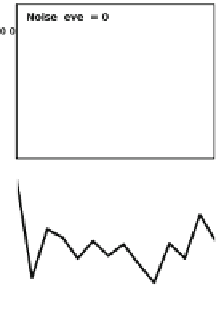Information Technology Reference
In-Depth Information
Fig. 10. Noise tolerance.
On the right uniformly distributed noise of increasing levels (grayscale
coded) is added to the visual prototype time series for the light-weight circle and the heavy
triangle. The PB values are determined and marked with a matching symbol. The white circle
and large black triangle show the PB values obtained during training without noise. On the left
the impact of the noise level is shown exemplarily for the visual prototype time series of the
circular shape.
5
Discussion
By introducing modifications to the learning algorithm of the RNNPB we were able
to achieve a significant 22-fold increase in speed (Tab. 1) for the storage of two 1-D
signals. It was also confirmed that the storage and retrieval of those time series was
stable and that learning converged in a well-behaved manner (Fig. 5). Admittedly, the
storage of other sequences with e.g. a different dimensionality, length or dynamic, may
well result in a different performance outcome.
After confirming flawless operation of the training algorithm we conducted three ex-
periments aiming at object categorization. While holding different objects (Sec. 3) in its
hand, the robot executes a motor sequence that induces multi-modal sensory changes.
During learning these high-dimensional perceptions are 'engraved' in the network. Si-
multaneously, low-dimensional PB values emerge unsupervised, coding for a sensori-
motor sequence characterizing the interplay of the robot with an object. We show that
2-D time series of length
T
=14
can be reliably represented by a 2-D PB vector and
that this vector allows learned sensory sequences to be recalled with a high accuracy
(Fig. 7 left). Furthermore, the geometrical relation of PB vectors of different objects
can be used to infer relations between the original high dimensional time series, e. g.
the sensation of a star-shaped object 'feels' more like a circular-shaped object than a
triangular-shaped one. Due to the experimental noise of single trials, identical objects
cause varying sensory impressions. Still, the RNNPB can be used to recognize those
(Fig. 6). Additionally, sensations belonging to unknown objects can be discriminated
from known (learned) ones. Moreover, sensations arising from different unknown ob-
jects can be kept apart from each other reliably (Fig. 9).






















































































































































































































































































































































































